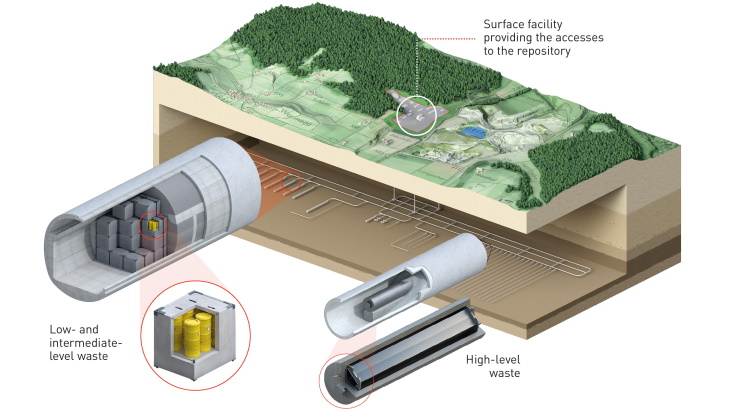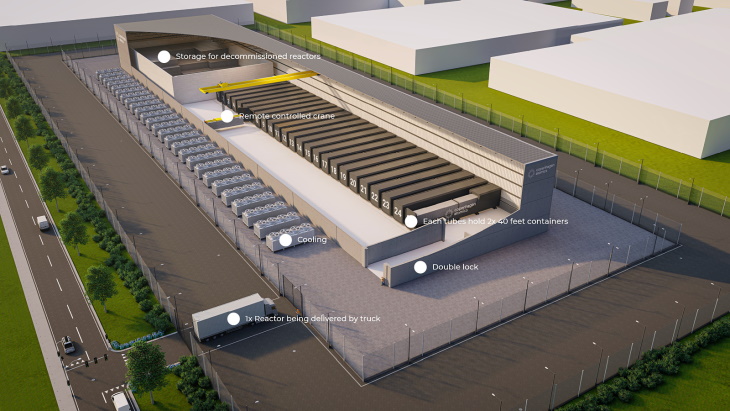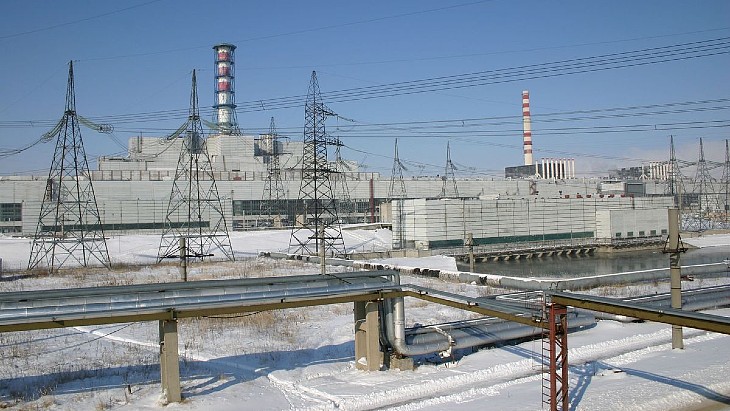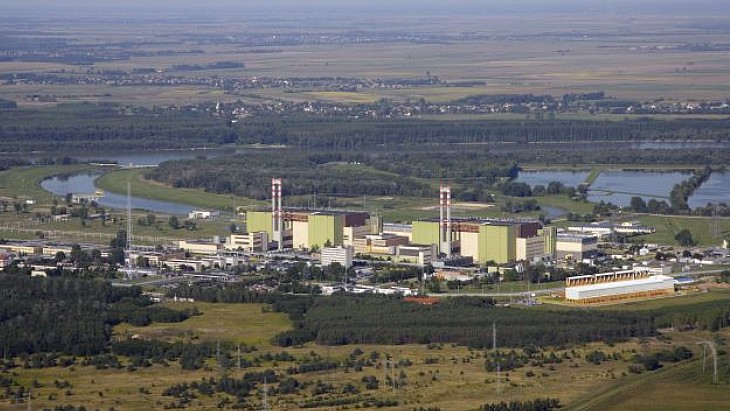ENEC and ADNOC team up to support UAE energy diversification
The Emirates Nuclear Energy Corporation and government-owned diversified energy group ADNOC are to evaluate the deployment of advanced nuclear technology such as small modular reactors to support the UAE's energy diversification strategy, and will look into using excess heat from the Barakah nuclear power plant in ADNOC's oil and gas operations.
_53899.jpg)
A strategic collaboration agreement to research and explore developing innovative energy solutions to enhance energy efficiency signed by the two companies involves a comprehensive technical and economic assessment to identify the best-fit nuclear reactor technologies for ADNOC by leveraging ENEC’s expertise in assessing technological performance in pilot projects as well as future technologies under development, ENEC said.
The agreement also covers feasibility studies to assess opportunities to use excess heat from Barakah, with recommendations for advanced technologies that can be demonstrated through existing or upcoming pilot projects.
Ahmed Al Mazrouei, nuclear research and development vice president at ENEC, said the collaboration was a significant step forward in the company's ongoing commitment to advancing new technologies and driving research and development in the UAE’s energy sector. "By focusing on cutting-edge nuclear innovations and exploring new methods to harness excess heat for industrial applications, we are strengthening the UAE’s green economy. Together with ADNOC, we will leverage our combined technical capabilities and expertise to identify and develop nuclear solutions that enhance energy security and sustainability in parallel," he said.
"In collaborating with ENEC, we will explore the deployment of small modular nuclear reactors as we develop innovative energy solutions to enhance our operational efficiency," ADNOC Senior Vice President for Technology and Innovation Ali Al Rawahi said. "Our partnership underscores our mutual commitment to scaling a reliable and clean energy source, as well as developing pioneering advancements in lower-carbon energy and technological innovation."
Founded in 1971, ADNOC - the Abu Dhabi National Oil Company - is a diversified energy group, with a network of fully integrated businesses operating across the energy value chain. The company, which claims already to be among the lowest carbon intensity oil and gas producers in the world, has allocated an initial USD23 billion to advance and accelerate lower-carbon solutions, and is investing in new energies and decarbonisation technologies to reach its ambition of net zero by 2045 and a commitment to zero methane emissions by 2030.
The new collaboration aligns with the UAE's Energy Strategy 2050, which aims to increase the contribution of clean energy sources and improve energy efficiency across the country, ENEC said.
The fourth and final unit of ENEC's Barakah nuclear power plant entered commercial operation in September. The plant is now generating 40 TWh annually, equivalent to 25% of the UAE’s electricity needs, while preventing the release of 22.4 million tonnes of carbon per year.
Applications lodged for Swiss waste disposal facilities
Switzerland's national radioactive waste disposal cooperative Nagra has applied to the Swiss Federal Office of Energy for a general permit for the construction of the planned deep geological repository for radioactive waste and a used nuclear fuel encapsulation plant.
_70752.jpg)
In September 2022, following a 14-year site selection process, Nagra proposed Nördlich Lägern in northern Switzerland as the site of a deep geological repository, while a used fuel encapsulation plant would be built at the existing Zwilag interim storage facility in Würenlingen in the canton of Aargau. The entrance to the repository, the so-called surface facility, would be constructed in the Haberstal area in the community of Stadel in canton of Zürich.
Applications for general authorisation consist of a safety report and a security report, as well as a report justifying the choice of the site. They also include an environmental impact study report and a report on the concordance with regional planning. With each application, Nagra defines the site of the installation (size and location of the main structures) as well as the maximum limit of exposure of people to radiation in the vicinity of the installation. For deep-geological disposal, the maximum capacity of the repository, the exclusion criteria and the temporary subsoil protection zone around the repository site must also be defined. In addition, there is the concept for the observation phase and the final closure of the installation. Nagra attached the corresponding files to its applications, which it submitted on 19 November.

The concept of the Swiss repository(Image: Nagra)
"We are demonstrating that we can construct and operate this deep geological repository safely - even if it will be challenging," said Nagra CEO Matthias Braun. "We are also showing that the repository is compatible with environmental protection. With this application, we are laying out the facts needed for Switzerland to decide on the safe geological disposal of the nation's radioactive waste."
The competent federal departments will examine by spring 2025 whether all the documents required by law have been provided. Nagra will then publish the entire application documentation and all the scientific reports online - three years earlier than required by law. The authorities will then begin a detailed examination of the content of the applications. The Swiss Federal Nuclear Safety Inspectorate (ENSI) and the Federal Nuclear Safety Commission (CNS) will then begin examining the content of the applications. This assessment is expected to be completed by 2027.
The Swiss Federal Office of Energy will issue the general authorisations based on the examination carried out by the authorities and, in particular, on the opinions of the federal departments concerned and the cantons. According to current planning, the Federal Council will decide on the application in 2029 and Parliament in 2030. A national referendum is expected to take place in 2031.
Nagra said: "With this step, Nagra wants to enable an early and meaningful debate about the project - in parallel with the technical review of the application by the authorities. Nagra will be available for questions and discussions."
"The cross-generational project of deep geological disposal needs to be debated as broadly as possible and should be legitimised as a result of a direct democratic process - in Switzerland, this includes a national referendum," Braun noted.
Once the general authorisation for the repository comes into force, geological studies will be carried out underground in the area of implantation (through the creation of an underground laboratory), with the aim of acquiring more in-depth knowledge with a view to the construction of the repository. The application for a building permit, then later the application for an operating permit, can then be submitted. According to current planning, the repository could come into operation and the first radioactive waste could be stored there from 2050.
Copenhagen Atomics, DeepGeo agree to collaborate
US-based multinational repository developer DeepGeo and Danish advanced reactor designer Copenhagen Atomics are to collaborate on better understanding both the radioactive materials and fuel needs of Copenhagen Atomics' small and modular thorium molten salt reactor.
_42999.jpg)
The cooperation agreement was signed in New York by Jam Pedersen, co-founder of Copenhagen Atomics, and Laura Salonga, vice president of industry relations at DeepGeo.
The partners said the agreement is "a first-of-a-kind for the global nuclear sector" and "represents a concrete step towards ensuring the long-term sustainability of nuclear energy".
Important aspects of the collaboration include technology, fuel and waste characterisation and the legislation and regulations of handling, transporting and disposing of these materials between countries.
Copenhagen Atomics is developing a containerised molten salt reactor. Moderated with unpressurised heavy water, the reactor consumes nuclear waste while breeding new fuel from thorium. Small enough to allow for mass manufacturing and assembly line production, the reactor has an output of 100 MWt.

A visualisation of a 1 GW plant based on Copenhagen Atomics' molten salt reactor (Image: UK Atomics)
Copenhagen Atomics' thorium reactors are expected to consume the transuranic elements in used nuclear fuel from conventional nuclear reactors, which radically reduces the amount of long-lived radioactive waste.
To achieve this, Copenhagen Atomics intends to separate used nuclear fuel from light water reactors into four streams: zircaloy, uranium, fission products and transuranics. Its reactor designs can make use of plutonium (a transuranic) to 'kickstart' the use of thorium.
DeepGeo says it is committed to providing services related to medium and low-level waste management and disposal as Copenhagen Atomics begins testing and demonstration. Initially, the collaboration between the parties aims to help establish a better understanding of the economy and requirements of this process, determining what ultimately is waste and what has commercial value.
The establishment of multinational interim storage facilities and repositories that can host a variety of waste forms would provide vital flexibility in support of novel nuclear technologies, applications and business models, says DeepGeo.
"Copenhagen Atomics reactors are able to burn spent nuclear fuel and get 10 times more energy out of it, than when that same fuel is used in a traditional nuclear reactor," Pedersen said. "Together with DeepGeo, Copenhagen Atomics will explore how we can make international handling of spent nuclear fuel radically more efficient and at the same time handle all waste streams responsibly.
"This partnership between Copenhagen Atomics and DeepGeo helps enable the conversion of spent nuclear fuel into a valuable resource rather than an expensive liability, which countries and companies have to deal with. Recycling a large share of spent nuclear fuel, this so-called 'nuclear waste', would allow them to sell it for a positive value, further covering the cost of recycling and transport."
DeepGeo President Link Murray added: "An innovative nuclear sector needs innovative back-end solutions. We are thrilled to be partnering with Copenhagen Atomics, which is again demonstrating that it is a pioneer in the nuclear sector. Working together we can better understand the value of different fuel and waste needs of advanced nuclear reactors, help to accelerate their deployment and ensure the future sustainability of nuclear energy."
The partners said they welcome interest from other nuclear technology and project developers that "are also ready to get serious about their future waste challenges" and explore innovative and multinational solutions.
Kursk NPP preparing for medical isotope production
Rosenergoatom says it will seek permission from regulator Rostekhnadzor in 2025 for the production of medical isotopes at the Kursk nuclear power plant in Russia.

The company, part of state nuclear giant Rosatom, said the plan for the production of a broad range of medical isotopes had been supported in a public consultation process carried out over the past month. It says more than 300 people took part.
The isotopes to be produced are samarium-153, iodine-131, iodine-125, molybdenum-99 and lutetium-177. They are used for the production of radiopharmaceuticals for the diagnosis and treatment of a range of health conditions included heart-related issues and cancers.
The production of the medical isotopes, as well as radiation-doped silicon, is currently only carried out in Russia at the Leningrad nuclear power plant.
Alexander Uvakin, Director of Kursk NPP, said: "The most important goal of our activities in the production of medical isotopes is the well-being and health of our fellow citizens, increasing the availability of modern methods of diagnosis and treatment of ailments. The nuclear industry benefits not only from its energy component. By developing competencies in the field of modern radiation technologies, we use the ability of our reactors not only to generate electricity, but also to produce products that are in demand in the country and in the world."
Nikolay Kushkovoy, Head of the Radiation Technologies Department of the Kursk NPP, said: "Due to the design features of the RBMK reactors ... without shutting down the reactor, it is possible to load a large amount of starting material, the so-called targets, simultaneously with different types of isotopes. Medical-grade isotopes are irradiated in short periods, allowing them to be produced in larger quantities. For example, it takes 120 hours to produce samarium-153, and iodine-131 takes three weeks. The irradiated target after removal with the help of special equipment will be placed in a packaging shipping container, then delivered to the customer by special transport. At the next stage, the target isotope necessary for the manufacture of radiopharmaceutical products is isolated from the irradiated target."
The Kursk nuclear power plant began producing the cobalt-60 isotope in 2018 - it has applications in sterilising foodstuffs, medical instruments and materials, for stimulating the growth and yield of grain and vegetable crops, disinfecting and cleaning industrial waste, radiation surgery for various pathologies, and for gamma flaw detection of various products.
Rosatom says that demand for its radioisotope products has been growing, with exports up 15% in 2023 and around 2.5 million diagnostic and therapeutic procedures performed worldwide using Rosatom's isotopes, which it says are supplied to around 170 companies in 50 countries.
Kursk nuclear power plant is home to four RBMK-1000 reactors. Kursk unit 1 was shut in 2021 after 45 years of operation, while unit 2 shut earlier this year. Units 3 and 4 are due to retire by 2031. They are being replaced by four VVER-TOI reactors at the nearby Kursk II site.
IAEA assesses operational safety at Hungary's Paks nuclear plant
An International Atomic Energy Agency mission team said the operator of Hungary's Paks nuclear power plant shows a commitment to safety, with areas of good practice to share with other operators globally, as well as providing some suggestions to further improve safety.

The Paks plant is located about 180 kilometres southwest of Budapest and is owned by Magyar Villamos Művek (MVM). The existing four units at Paks are VVER-440 reactors that started up between 1982 and 1987 and they produce about half of the country's electricity. Their design lifetime was for 30 years but that was extended in 2005 by 20 years, to between 2032 and 2037, and there are plans for a further 20-year extension.
The aim for International Atomic Energy Agency (IAEA) Operational Safety Review Team (OSART) missions is to assess safety performance against IAEA safety standards, highlight areas of good practice and propose improvements.
During the 18-day mission, the areas of good practice identified by the 13-member team were: the development and implementation of a monitoring and repair programme for confinement systems; the storage of geospatial information on plant structures and components and the sharing of data on different platforms; and the development of software to predict potential initiating emergency events and the progression of events.
The suggestions to further improve safety included: consider enhancing measures to maintain measurement equipment, including inspections, calibrations, storage and traceability; consider reinforcing plant programmes and work practices to ensure that, in the event of an earthquake, the potential impact of non-fixed items on safety-related equipment is minimised, and consider enhancing processes, procedures and practices to provide personnel with the necessary instructions in the industrial areas of the plant.
OSART team leader Yury Martynenko, senior nuclear safety officer at the IAEA, said: "The team was pleased to see that the plant was very well prepared and cooperated fully and openly with IAEA experts during the mission. The managers and staff of Paks NPP are committed to improving the operational safety and reliability of their plant, and we were pleased to see many actions in progress."
Péter János Horváth, CEO of MVM Paks Nuclear Power Plant Ltd, said: "It was in the spirit of continuous learning that we had requested the IAEA review. The OSART mission has allowed us to make an in-depth assessment of our work. The recommendations and suggestions will help us to continuously improve the plant's operational safety, and thanks to the expertise of our team, we can also contribute to the enrichment of global best practices."
This was the fourth OSART review mission to Paks NPP - the first was in 1988, followed by ones in 2001 and 2014.
A draft copy of the report has been provided to the plant management, and following any factual comments provided, the final copy will be submitted to the Hungarian government within three months. The experts on the review mission were from Argentina, Bulgaria, China, the Czech Republic, Russia, South Africa, Switzerland, Ukraine, the United Arab Emirates and the USA, as well as three IAEA officials
No comments:
Post a Comment